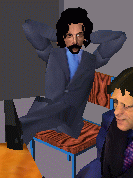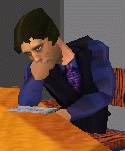
Social Phobia at About.com
Therapy Links at About.com


Social phobia is a common and disabling anxiety disorder (Kessler et al., 1994; Rapee, 1995). Sufferers fear, and whenever possible avoid, social and performance situations (e.g., meeting people, eating in restaurants, public speaking). These fears often lead them to underperform at work and make it difficult for them to establish and maintain close relationships. Complications include alcohol abuse, depression and suicide.
Cognitive-behaviour therapy, the leading psychological treatment, involves systematic exposure to feared social situations and the use of cognitive techniques to help patients identify and challenge anxiety-related negative thoughts. Controlled trials have shown that existing cognitive-behavioural treatments are effective, but that there is also considerable room for improvement, as in more than half of patients substantial social fears remain (Chambless & Gillis, 1993; Mattick & Peters, 1988).
Two developments are likely to enhance the
effectiveness of cognitive-behavioural therapy. First, improved
understanding of the distorted information processing strategies
utilised by social phobics. Second, better ways of presenting patients
with realistic and controllable social situations as part of therapy.
In principle, virtual reality could substantially contribute to both of
these developments.
Virtual Reality
Virtual reality (VR) is a powerful technique that uses computer representations to transform people's sense of presence, so that they feel themselves to be in a virtual environment rather their current one. This presence-transforming function enables people's environments to be precisely manipulated in a way that is not possible in the psychological laboratory or the everyday world. Some applications of VR to psychological therapy have recently been reported (e.g., Carlin, Hoffman & Weghorst, 1997), but the field is still relatively new and undeveloped.
Research into the possibility of using VR in a mental health setting has tended to concentrate upon its application to problems such as fear of heights, fear of flying and fear of spiders. It has been regarded as a natural extension of the systematic exposure component of cognitive-behaviour therapy. The first feasibility studies were conducted at Georgia Tech in Atlanta and used VR to treat acrophobia, or fear of heights (Rothbaum, Hodges, Kooper, Opdyke, Williford & North 1995). Results from these early trials suggested that subjects did indeed experience a wide range of physical anxiety symptoms consistent with their being present in a threatening situation involving heights. Not only was the affect generated by the experience of the right kind, subjects also reported a subsequent reduction in anxiety in real life situations and were less inclined to avoid heights.
Various studies report similar success in
the application of VR to a variety of other phobias. Fear of flying has
been treated, as has fear of Spiders and agoraphobia. The success of
these pilot studies has been such that several companies have been set
up in the United States with the aim of developing and marketing
commercial virtual reality phobia treatments. In 1998 a virtual reality
treatment for public speaking apprehension was attempted with apparent
success. Although it was not a controlled clinical trial and no
invetsigation was conducted into factors contributing to its
effectiveness, the study was significant because it signalled an
attempt to extend VR exposure therapy to the treatment of social
phobias, where interaction of some kind with other people rather than
with an inert environment is the anxiety provoking stimulus.
Independently of the research in the United States, a Masters research
project was being conducted at UCL in 1998 into the potential of using
VR for the the treatment of fear of public speaking. This line of
enquiry was suggested by previous research in the department into
interaction between users of a collaborative virtual environment. Key
findings from this project (Pertaub 1998, Pertaub, Slater, Pertaub
& Steed 1999) were that participants reacted to a virtual audience
as though it were a real audience, in that they were more anxious and
rated their own performance less highly after speaking to a virtual
audience that was programmed to respond to them in a negative fashion
than after speaking to virtual audiences programmed to respond
neutrally or positively.
Current Research at UCL
Current research in this field aims to further develop the VR application to social anxiety in a series of pilot studies which will provide a more comprehensive validation of the procedure as an analogue of feared social situations and develop the technology to allow virtual reality to be used as a sophisticated instrument for assessing information processing biases and enhancing treatment effects.
Specific issues that will be addressed in the pilot work are as follows:
- Developing additional virtual social environments. Public speaking is only one of the situations feared by patients with social phobia and there is some evidence that the processes involved may be slightly different from those in other social situations. To enhance the generalisability of future research, we wish to develop other prototypic social environments, such as being introduced to a group of strangers at a party and a one-to-one conversation with a stranger. Both are technically feasible with the expertise assembled in Professor Slater's laboratory. We also wish to refine the behaviour of the virtual audience. For example, in the neutral condition in the current implementation the audience is largely inert. However, real audiences engage in a variety of ambiguous behaviours that could easily be interpreted in a negative fashion by a patient with social phobia (e.g., looking down at one's notes, frowning while concentrating). Programming for these responses will be developed.
- Validation of the psychological reality of the virtual environment. Students who score high and low on measures of social anxiety (FNE, SPAI, PRCS, see reference list) will be compared in terms of their self-reported anxiety and heart rate while interacting with each of the virtual social environments. They will also rate the perceived similarity of the virtual and real environments and will be interviewed about any perceived discrepancies. The latter information will be fed back into the programming to enhance the "sense of presence" of the virtual environment.
- Detection of gaze. In future research, we wish to investigate the subjects’ attention to key aspects of the social environment. In order to be able to do this on line, rather than just by indirect means such as subsequent recognition memory, we need to be able to track subjects' gaze and link this information with events in the virtual environment. We have identified an eye tracking system that could in principle be used within the confined space of the virtual reality headset. In pilot work, we will customise the system for inclusion in the headset and will perform validation studies, involving tracking a moving target in the virtual array and detecting off-fixation-point visual events.
- Exploration of the clinical utility of virtual social environments SIZE="2">. It is difficult to arrange a series of realistic social interactions in routine therapy sessions. Virtual reality clearly has the advantage of being able to provide suitable social tasks at the push of a button. This should enhance the effects of exposure therapy. However, recent work by one of the applicants (Clark, 1999) indicates that exposure is of only limited value unless accompanied by appropriate manipulations of attention and safety behaviours that can be used to maximise the belief-disconfirming effects of exposure. We will therefore explore the optimal way of utilising the virtual environment in a series of case studies with social phobic patients. For example, we will be able to demonstrate selected inattention to positive responses in others by replaying the virtual interaction to a patient. We will also be able to allow patients to experiment with dropping safety behaviours and provide inoculation against negative responses from others..